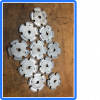Bliksem
Active Member
I don't have enough pics to show how its all done but the older Hornady shell plates did not have the lower groove for the EZ-ject and used a wire to eject the brass/completed cartridge. This is a problem if you want use station 5 for a Lee collet crimp die as it will hit the wire.
As I have a fair number of Hornady presses of various vintages I ended up with a mix of shell plates that would not fit when needed. In addition I have upgraded a number of my presses with the newer EZ-ject conversion kits.
I'm spoiled because I have access to a machine shop with Haas mills and lathes but I typically do my machining on Chinesium manual mill and lathes at home. The material that these plates are made of has weird machining characteristics as it is MIM as far as I know. I tried to machine these plates before at home but my lathes/me could not do it.
About a year ago I had my machinist friend at work modify 6 plates and he and I learned a lot about the weird metal that these plates are made of. Tried the large lathes in the shop but what worked best was to set up the plates in the Haas mill and have at it. 1/4" carbide endmills with small and slow feeds has the best results.
Here is a pic of the latest batch of plates converted. There is included a factory original at the top right for reference. (Twist your head 90* to the right to get the proper view.)

As I have a fair number of Hornady presses of various vintages I ended up with a mix of shell plates that would not fit when needed. In addition I have upgraded a number of my presses with the newer EZ-ject conversion kits.
I'm spoiled because I have access to a machine shop with Haas mills and lathes but I typically do my machining on Chinesium manual mill and lathes at home. The material that these plates are made of has weird machining characteristics as it is MIM as far as I know. I tried to machine these plates before at home but my lathes/me could not do it.
About a year ago I had my machinist friend at work modify 6 plates and he and I learned a lot about the weird metal that these plates are made of. Tried the large lathes in the shop but what worked best was to set up the plates in the Haas mill and have at it. 1/4" carbide endmills with small and slow feeds has the best results.
Here is a pic of the latest batch of plates converted. There is included a factory original at the top right for reference. (Twist your head 90* to the right to get the proper view.)

Last edited:
